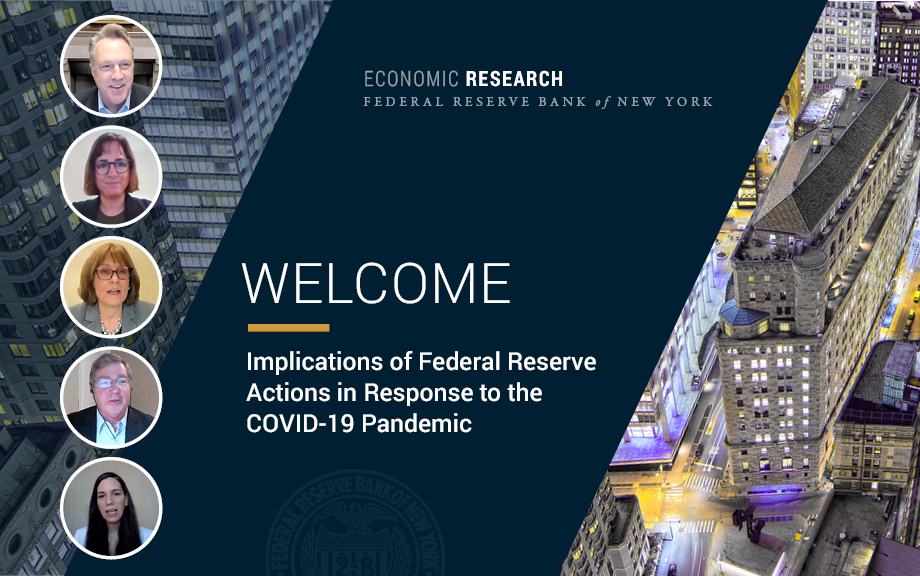
On September 30 and October 1, 2021, the New York Fed held a virtual conference on the implications of the Fed’s actions in response to the COVID-19 pandemic. New York Fed President John Williams gave the opening and concluding remarks.
At the New York Fed, our mission is to make the U.S. economy stronger and the financial system more stable for all segments of society. We do this by executing monetary policy, providing financial services, supervising banks and conducting research and providing expertise on issues that impact the nation and communities we serve.
Nina Boyarchenko, Anna Kovner, and Antoine Martin

On September 30 and October 1, 2021, the New York Fed held a virtual conference on the implications of the Fed’s actions in response to the COVID-19 pandemic. New York Fed President John Williams gave the opening and concluding remarks.
Fulvia Fringuellotti and João A. C. Santos
Collateralized loan obligation (CLO) issuances in the United States increased by a factor of thirteen between 2009 and 2019, with the volume of outstanding CLOs more than doubling to approach $647 billion by the end of that period. While researchers and policy makers have been investigating the impact of this growth on the cost and riskiness of corporate loans and the potential implications for financial stability, less attention has been paid to the drivers of this phenomenon. In this post, which is based on our recent paper, we shed light on the role that insurance companies have played in the growth of corporate loans’ securitization and identify the key factors behind that role.
Hunter L. Clark

A Liberty Street Economics post from last summer by Matthew Higgins and Thomas Klitgaard contained an assessment of the Phase One trade agreement between the United States and China. The authors of that note found that, depending on how successfully the deal was implemented, the impact on U.S. economic growth could have been substantially larger than originally foreseen by many of its critics, as a result of the fact that the pandemic had depressed the U.S. economy far below its potential growth path. Here we take another look at these considerations with the benefit of an additional year’s worth of trade data and a much different economic environment in the United States.
Jan J. J. Groen and Adam I. Noble

Oil prices have increased by nearly 60 percent since the summer of 2020, coinciding with an upward trend in global inflation. If higher oil prices are the result of constrained supply, then this could pose some stagflation risks to the growth outlook—a concern reflected in a June Financial Times article, “Why OPEC Matters.” In this post, we utilize the demand and supply decomposition from the New York Fed’s Oil Price Dynamics Report to argue that most of the oil price increase over the past year or so has reflected improving global demand expectations. We then illustrate what these changing global demand expectations might mean for near-term global inflation developments.
Adam Copeland, Darrell Duffie, and Yilin (David) Yang
A concern of the Federal Reserve is how to manage its balance sheet and whether, over the long run, the balance sheet should be small or large. In this post, we highlight results from a recent paper in which we show how, even during a period of “ample” reserves, the Fed’s management of its balance sheet had material impacts on funding markets and especially the repo market. We argue that the Fed’s “balance-sheet normalization” from March 2017 to September 2019—under which aggregate reserves declined by more than $950 billion—combined with post-crisis liquidity regulations, stressed the intraday management of reserves of large bank holding companies that are active in wholesale funding markets resulting in higher repo rates and spikes in such.
Victoria E. Agwam, Pablo D. Azar, and Kyra Frye

While the shocks from COVID-19 were concentrated in a handful of contact-intensive industries, they had rippling effects throughout the economy, which culminated in a considerable decline in U.S. GDP. In this post, we estimate how much of the fall in U.S. GDP during the pandemic was driven by spillover effects from the productivity losses of contact-intensive industries.
Marco Del Negro, Keshav Dogra, Shlok Goyal, Alissa Johnson, and Aidan Gleich

This post presents an update of the economic forecasts generated by the Federal Reserve Bank of New York’s dynamic stochastic general equilibrium (DSGE) model. We describe very briefly our forecast and its change since June 2021.
Olivier Armantier, Fatima Boumahdi, Leo Goldman, Gizem Koşar, Jessica Lu, Giorgio Topa, and Wilbert van der Klaauw

With the recent surge in inflation since the spring there has been an increase in consumers’ short-run (one-year ahead) and, to a lesser extent, medium-run (three-year ahead) inflation expectations (see Survey of Consumer Expectations). Although this rise in short- and medium-run inflation expectations is relevant for policymakers, it does not provide direct evidence about “un-anchoring” of long-run inflation expectations. Roughly speaking, inflation expectations are considered un-anchored when long-run inflation expectations change significantly in response to developments in inflation or other economic variables, and begin to move away from levels consistent with the central bank’s (implicit or explicit) inflation objective. In that case, actual inflation can become unmoored and risks drifting persistently away from the central bank’s objective. Well-anchored long-run inflation expectations therefore represent an important measure of the success of monetary policy. In this post, we look at the current anchoring of consumers’ long-run inflation expectations using novel data from the Survey of Consumer Expectations (SCE). Our results suggest that in August 2021 consumers’ five-year ahead inflation expectations were as well anchored as they were two years ago, before the start of the pandemic.
Jason Bram and Joelle Scally

As we mourn the tragic losses of the 9/11 attacks twenty years on, we thought it would be appropriate to re-examine the remarkable resilience New York City’s economy has shown over the years—a resilience that is once again being tested by the ongoing COVID-19 pandemic. In this Liberty Street Economics post, we look at how Lower Manhattan, in particular, has changed since that tragedy on a number of dimensions, and use that as a framework to think about how the city might change as a result of the COVID pandemic.
Andrew Haughwout and Belicia Rodriguez

In our previous post, we illustrated the recent extraordinarily strong growth in home prices and explored some of its key spatial patterns. Such price increases remind many of the first decade of the 2000s when home prices reversed, contributing to a broad housing market collapse that led to a wave of foreclosures, a financial crisis, and a prolonged recession. This post explores the risk that such an event could recur if home prices go into reverse now. We find that although the situation looks superficially similar to the brink of the last crisis, there are important differences that are likely to mitigate the risks emanating from the housing sector.
Liberty Street Economics features insight and analysis from New York Fed economists working at the intersection of research and policy. Launched in 2011, the blog takes its name from the Bank’s headquarters at 33 Liberty Street in Manhattan’s Financial District.
The editors are Michael Fleming, Andrew Haughwout, Thomas Klitgaard, and Asani Sarkar, all economists in the Bank’s Research Group.
Liberty Street Economics does not publish new posts during the blackout periods surrounding Federal Open Market Committee meetings.
The views expressed are those of the authors, and do not necessarily reflect the position of the New York Fed or the Federal Reserve System.
We encourage your comments and queries on our posts and will publish them (below the post) subject to the following guidelines:
Please be brief: Comments are limited to 1,500 characters.
Please be aware: Comments submitted shortly before or during the FOMC blackout may not be published until after the blackout.
Please be relevant: Comments are moderated and will not appear until they have been reviewed to ensure that they are substantive and clearly related to the topic of the post.
Please be respectful: We reserve the right not to post any comment, and will not post comments that are abusive, harassing, obscene, or commercial in nature. No notice will be given regarding whether a submission will or will
not be posted.
Comments with links: Please do not include any links in your comment, even if you feel the links will contribute to the discussion. Comments with links will not be posted.
The LSE editors ask authors submitting a post to the blog to confirm that they have no conflicts of interest as defined by the American Economic Association in its Disclosure Policy. If an author has sources of financial support or other interests that could be perceived as influencing the research presented in the post, we disclose that fact in a statement prepared by the author and appended to the author information at the end of the post. If the author has no such interests to disclose, no statement is provided. Note, however, that we do indicate in all cases if a data vendor or other party has a right to review a post.
